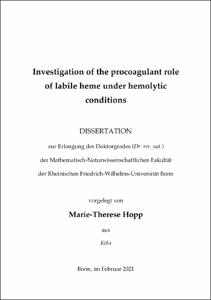Investigation of the procoagulant role of labile heme under hemolytic conditions

Investigation of the procoagulant role of labile heme under hemolytic conditions

| dc.contributor.advisor | Imhof, Diana | |
| dc.contributor.author | Hopp, Marie-Therese | |
| dc.date.accessioned | 2021-07-19T12:24:38Z | |
| dc.date.available | 2021-07-19T12:24:38Z | |
| dc.date.issued | 19.07.2021 | |
| dc.identifier.uri | https://hdl.handle.net/20.500.11811/9228 | |
| dc.description.abstract | Severe intravascular hemolysis leads to the excessive release of labile heme into the vascular compartment, thereby overwhelming the heme-binding capacity of the protective heme- scavenging system. As a consequence, labile heme activates proinflammatory signaling pathways and the complement system, which is often regulated by transient heme binding to involved proteins. Moreover, patients with hemolytic disorders frequently suffer from thrombotic complications. Though these procoagulant responses might be of multifunctional origin, several studies suggest a major role of labile heme. In the present thesis, the current knowledge of heme as a prothrombotic alarmin is comprehensively compiled. This analysis revealed essential knowledge gaps on the level of heme-induced signaling pathways concerning the cellular components of the blood coagulation system, yet also on the level of direct heme-protein interactions that are only rarely investigated so far. Two approaches should be applied herein in order to address both aspects using specific examples. Initially, the binding of heme to the blood coagulation inhibitor activated protein C was investigated. Two heme-regulatory motifs were identified and characterized. The functional consequences of this interaction were analyzed by various biochemical and physiological relevant assays, in particular confirming the procoagulant role of heme by inhibition of the enzyme. In the second approach, data from 46 publications on the effect of heme under hemolytic conditions were curated and contextualized resulting in a network (HemeKG) that allows for detailed analysis of relevant signaling pathways, as exemplified by the TLR4 signaling pathway. The present thesis contributes to the current knowledge on heme as a prothrombotic molecule through the characterization of the enzyme activated protein C as a further, heme- regulated protein of the blood coagulation system and by providing HemeKG as a basis for future heme-triggered pathway and pathology analysis as well as for the development of suitable drugs for the treatment of hemolysis-driven thrombosis. | en |
| dc.language.iso | eng | |
| dc.rights | In Copyright | |
| dc.rights.uri | http://rightsstatements.org/vocab/InC/1.0/ | |
| dc.subject | Häm | |
| dc.subject | Häm-bindende Proteine | |
| dc.subject | Hämolyse | |
| dc.subject | Thrombose | |
| dc.subject | Blutgerinnung | |
| dc.subject | aktiviertes Protein C | |
| dc.subject | heme | |
| dc.subject | heme-binding proteins | |
| dc.subject | hemolysis | |
| dc.subject | blood coagulation | |
| dc.subject | activated protein C | |
| dc.subject.ddc | 500 Naturwissenschaften | |
| dc.subject.ddc | 610 Medizin, Gesundheit | |
| dc.title | Investigation of the procoagulant role of labile heme under hemolytic conditions | |
| dc.type | Dissertation oder Habilitation | |
| dc.publisher.name | Universitäts- und Landesbibliothek Bonn | |
| dc.publisher.location | Bonn | |
| dc.rights.accessRights | openAccess | |
| dc.identifier.urn | https://nbn-resolving.org/urn:nbn:de:hbz:5-63033 | |
| ulbbn.pubtype | Erstveröffentlichung | |
| ulbbnediss.affiliation.name | Rheinische Friedrich-Wilhelms-Universität Bonn | |
| ulbbnediss.affiliation.location | Bonn | |
| ulbbnediss.thesis.level | Dissertation | |
| ulbbnediss.dissID | 6303 | |
| ulbbnediss.date.accepted | 30.06.2021 | |
| ulbbnediss.institute | Mathematisch-Naturwissenschaftliche Fakultät : Fachgruppe Pharmazie / Pharmazeutisches Institut | |
| ulbbnediss.fakultaet | Mathematisch-Naturwissenschaftliche Fakultät | |
| dc.contributor.coReferee | Biswas, Arijit | |
| ulbbnediss.contributor.orcid | https://orcid.org/0000-0002-0883-7564 | |
| ulbbnediss.contributor.gnd | 1239090951 |
Files in this item
This item appears in the following Collection(s)
-
E-Dissertationen (4398)




